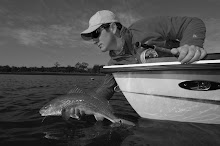
There has always been a lot of speculation over the future of North Carolina's fisheries. In large part this speculation has existed solely in the minds of the concerned recreational anglers, sportsmen and wildlife rehabilitation experts and conservation groups that have been entrenched in the battle to remove gill nets from North Carolina's coastal waters.
Interestingly enough gill nets are illegal in North Carolina's fresh waters or inland waters as they are referred to. In the last decade many angler conflicts have arisen between commercial and recreational fishermen as the competition for fish in coastal waters has increased. The long standing argument is that gill nets not only take the fish they are targeting they also reap a lot of bycatch including finfish, (red drum, striped bass, sea trout etc.), waterfowl (ducks, geese and shorebirds), and last and most importantly sea turtles, (kemp ridleys, hawksbill, green and loggerhead) and sturgeon, both of which are protected by the Endangered Species Act of 1973.
Since the late 90's North Carolina's commercial gill netters in the Pamlico Sound have operated under the protection of Permit no. 1528 which grants these commercial fishermen the right to fish so long as they don't kill or interfere with more than 120 sea turtles in a three year period. Permit 1528 is basically a waiver on the ESA which comes up for review in Dec of 2010.
For the first time in the fisheries history the Pamlico Sound Gill Net fishery was officially closed for the season due to an exceptionally high number of Green Sea Turtle interactions with gill nets in the 4 week season.
See NCDMF Statement attached:
FLOUNDER SEASON CLOSES TO PROTECT SEA TURTLES
MOREHEAD CITY – Waters in Pamlico Sound will close Thursday to the use of large-mesh gill nets. The intent of the closure is to protect threatened and endangered sea turtles.
The estimated number of live green sea turtles caught in flounder nets this season will surpass the maximum number allowed by a special permit from the National Marine Fisheries Service.
North Carolina manages the large-mesh gill net fishery in Pamlico Sound under a federal permit authorized by Section 10 of the Endangered Species Act, which went into effect after numerous sea turtle strandings in Pamlico Sound in 1999 and 2000. Investigations identified the deep-water, large-mesh gill net fishery for southern flounder as the primary source for the sea turtle interactions and subsequent mortalities.
The permit authorizes a limited shallow water fishery along the Outer Banks and mainland side of Pamlico Sound and mandates observer coverage and weekly reporting. The permit also requires a season closure when the number of sea turtle take estimates reaches pre-set thresholds established by NMFS.
As of Friday, estimates of live green sea turtle interactions were at 111. The Section 10 Permit requires closure of the fishery when the estimated takes exceed 120 live green sea turtles.
Additionally, six more takes of green sea turtles were documented by Tuesday, which when extrapolated, will surpass the threshold for estimated green sea turtle takes.
The closure starts at 6 p.m. Thursday and will prohibit the use of gill nets with larger than 4 ¼-inch stretched mesh. It will remain in effect for the rest of the 2009 southern flounder season.
The closure does not prohibit the use of small mesh gill nets (smaller than or equal to 4 ¼-inch stretched mesh), and observations of the small mesh fishery will continue.
###
nr-45-09
MOREHEAD CITY – Waters in Pamlico Sound will close Thursday to the use of large-mesh gill nets. The intent of the closure is to protect threatened and endangered sea turtles.
The estimated number of live green sea turtles caught in flounder nets this season will surpass the maximum number allowed by a special permit from the National Marine Fisheries Service.
North Carolina manages the large-mesh gill net fishery in Pamlico Sound under a federal permit authorized by Section 10 of the Endangered Species Act, which went into effect after numerous sea turtle strandings in Pamlico Sound in 1999 and 2000. Investigations identified the deep-water, large-mesh gill net fishery for southern flounder as the primary source for the sea turtle interactions and subsequent mortalities.
The permit authorizes a limited shallow water fishery along the Outer Banks and mainland side of Pamlico Sound and mandates observer coverage and weekly reporting. The permit also requires a season closure when the number of sea turtle take estimates reaches pre-set thresholds established by NMFS.
As of Friday, estimates of live green sea turtle interactions were at 111. The Section 10 Permit requires closure of the fishery when the estimated takes exceed 120 live green sea turtles.
Additionally, six more takes of green sea turtles were documented by Tuesday, which when extrapolated, will surpass the threshold for estimated green sea turtle takes.
The closure starts at 6 p.m. Thursday and will prohibit the use of gill nets with larger than 4 ¼-inch stretched mesh. It will remain in effect for the rest of the 2009 southern flounder season.
The closure does not prohibit the use of small mesh gill nets (smaller than or equal to 4 ¼-inch stretched mesh), and observations of the small mesh fishery will continue.
###
nr-45-09
The crew of Redfish Can't Jump are glad to see the closure and at the same time disappointed that it took this type of loss of marine life to achieve this seasonal closure. An intent to sue the NCDMF and the NCMFC was filed yesterday by the Karen Beasley Sea Turtle Hospital in Topsail, NC and we support their effort and courage they have put forth to protect these and many other important marine species here in North Carolina's coastal waters.
More to come...










